Established as a national park in 1982, Similan Islands are an
archipelago of 11 islands in Phang Nga Province 70km off the coast at
Andaman Sea, covering an area of 70sqkm. With a rich marine life
consisting of magical hard/soft coral reefs, crystal clear waters and
white beaches it is concidered to be one of the best diving sites in the
world.
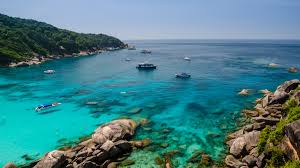
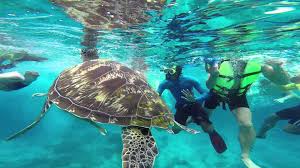
Apart from the rich coral life, the islands are also home to number of bird species. Nicobar Pigeons are very common and will be seen everywhere. Bird species like white-bellied sea eagle, Asian koel, black kite are seen regularly. See checklist of bird species on our wildlife section for Similan Islands.The park headquarters is based on Ko Miang. There are some bungalows and tents available for rent from HQ only, but since the accommodation options are limited and hard to obtain, the visitors are advised to stay in Khao Lok on mainland and do daytrips. There are plenty of hotels and guesthouses nearby the pier to choose from. There are restaurants on Ko Miang and Ko Similan only, meals are a bit more expensive as the ingredients are brought in from the mainland for tourism only.The ideal time to visit Similans is December to April when it is the dryer season with clear waters making it best time for scuba diving and snorkelling. The national park is open from 16th October until 15th May (Confirmed with park officials September 2016).The entrance fee to the park is 500 THB for foreigners and 100 THB for local tourists (children 50 THB). Boat trips to the islands can be arranged at any hotel or agency at the mainland, no advance bookings needed as the earliest boats leave the pier at Khao Lok around 8:30am. Tickets can also be arranged prior to departures.
Attractions of Mu Ko Similan:-
1.Khao Lak:-Approximately
60km north from Phuket and 74 km from Phuket International Airport,
Khao Lak is a series of villages along the mainland coastline. The area
is not part of the national park but is a popular departure point for
liveaboard and other boat services. Since the overnight options on
Similan Islands are limited and hard to obtain, most visitors stays in
resorts in this area and do daytrips to the islands.The Khao Lak Pier is
the nearest pier the boats operates to the islands from. The pier is 65
km from the main islands, 55 km from Ko Bon and 72km from Ko Tachai.
Most resorts does help to arrange boat trips, there are also some
agencies in the main villages.Mu Ko Similan National Park Office where
the accommodation bookings can be arranged from is also located in this
area near the pier.
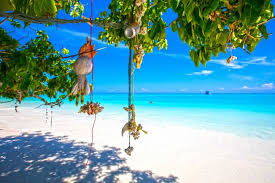
2.Ko Huyong:- the most southern island with a water depth of 10-15 meters around. It has the longest white beach in the national park which is also a nesting place for sea turtles. Apart from swimming, it is ideal for scuba diving.
3.Ko Payang:-With rocky hills and rock formations around the island. Ideal for snorkelling and scuba diving.
4.Ko Payan:-With rocky hills and rock formations around the island. Ideal for scuba diving.
5.Ko Miang, HQ:-The second largest island in the national park where the headquarters is located. It is home to two beautiful white beaches in 20 mins walking distance from each other.The island offers many activities like scuba diving, snorkelling, swimming, trekking and wildlife study.Ko Miang is the only island where bungalows are available for rent. Rooms are from 600B up to 2000B and can only be booked through National Park, Wildlife and Plant Conservation Department (DNP). There is also a camping area in the island and tents can be rent from HQ for 400B, with accessories included up to 570B a day. Visitors are not allowed to use their own tents.
6.Ko Ha & Ko Hok:-Smaller island on the east side of Ko Miang, possibly the best snorkeling and diving location in the park. It consists of hard and soft coral with a very rich sea life.
7.Ko Bayu:-Island a mid size island located on north of Ko Miang.
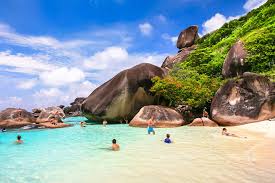
8.East of Eden:-Home
to the biggest coral head called "The Orchid Garden" and no doubt one
of best diving sites in Thailand. It was closed due to significant
damage it took by coral bleaching caused by 2010 Reverse Indian Ocean
Dipole but re-opened after some recovery back in 2013 diving
season.Starting at shallows of 6m, the reefs steply reaches the depths
of 35 with an avarage depth of 20, visibility of 10-30m and medicum
current. The site is ideal for snorkellers and all level of scuba
divers, for night diving too. The Orchid Garden starts at 25m and rises
to 12m, covered with soft corals like staghorn, table, pore corals,
orange/red gogonian sea fans, anemones and colourfull feather star
worms.Hawksbill/green sea turtles, ribbon eel, blue ring angelfish,
blueface angelfish, half-moon triggerfish, clown triggerfish, false
pipefish, giant moray, yellow longnose butterflyfish, royal angelfish,
potato cod, ornate ghost pipefish are few of many species found in the
reef. The deeper end of the reef is sandy sea bed, home to bluespotted
stingray, garden eels, blacktip and leopard sharks. Larger sharks may be
seen passing by.
9.West of Eden:-Located on the west side of Ko Bayu, it consists of large boulders covered with gorgonian sea fans, anemones, feather stars and hard/soft corals, some canyons and sandy seabed. Shallow waters are ideal for less experienced divers.The depth is 12-35m+ with 20-25m visibility and medium current.Green/hawksbill sea turtles, red tooth triggerfish, red fire gobies and black and white-tip reef sharks at lower depths are common.
10.Ko Similan:-Island the largest island located north with an average depth of 25m around. It has a small bay on western side. The island is ideal for hiking, scuba diving, snorkeling and swimming. There is also a rock formation with good view over the sea, a smaller viewpoint.
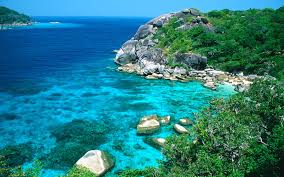
11.Elephant Head Rock:-Locally
known as Hin Pousar, Elephant Head Rock is an unusually shaped rock
situated southwest side of Koh Similan ideal for diving only. The dive
site is a bit more challenging compared to other sites in the islands
due to surge and current that may happen.The dive site offers
swim-throughs, underwater tunnels and hide-outs for fishes. Species
found in these waters are bicolour parrotfish, large snappers, lionfish,
Olive ridley sea turtle, hawkbill turtle, spider crabs, blue-ringed
angelfish, leopard shark and McCosker's flasher.The southern side of the
deep waters consists of submerged pinnacles where reef sharks may be
seen.
.12.Ko Ba-Ngu:-Island , the most northern of original 9 islands. It is ideal for scuba diving at the northern side with depth of 10-35 meters.
No comments:
Post a Comment